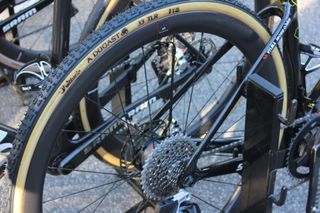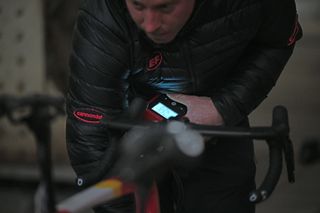Marianne Vos rides self-inflating tyre system to UCI Gravel World Championship victory
Vos used a €3.898,00 wheelset with a kinetic compressor to win her first mixed surface rainbow jersey


Marianne Vos took victory at the 2024 Gravel World Championships using a self-inflating tyre system.
Vos beat out favorite Lotte Kopecky in a two-up sprint, which crucially, ended on a smooth tarmac road.
Vos, along with other Visma-Lease-a-bike trade teammates used tyre reinflation devices from Dutch company Gravaa, allowing them to optimise tyre pressures on different surfaces throughout the race.

How does Gravaa's tyre inflation technology work?
The ability to change tyre pressures on the fly is something that can prove incredibly useful in mixed-surface racing. Lower tyre pressures can yield more grip when the going gets rough, and oftentimes improve rolling resistance too by helping to soak up more of the bumps on the course. Pump the tires back up and, well, perhaps you can sprint a little bit quicker on tarmac...
Clearly then, the technology lends itself to the likes of gravel racing and races such like Paris-Roubaix - where the technology made its first WorldTour debut back in 2022.
The Gravaa works by housing a tiny compressor inside the wheel hub. Pressure build-up is then fed into the tyres via an electronically controlled Presta valve, which allows riders to deflate and inflate tyres while riding along.

Visma-lease-a-bike riders from different nations were seen using the Gravaa setup.
Clearly you can't fit a workshop-sized compressor, running off mains power inside a wheel hub though, so Gravaa has come up with a solution that doesn't require external power and can fit within a wheel hub.
Gravaa uses a kinetic compressor system that uses the rotation of the wheel to pressurize air from the surroundings. Speaking to Cycling Weekly, Gertjan van Ginderen, Founder of Gravaa said "The rate of inflation is proportional to distance travelled. When running a 42mm tyre, the air pressure can be increased by around 0.8 bar (11.5 PSI) per kilometer."

Tyre pressure is all controlled from these small buttons on the handlebars.
The system is entirely controlled from the handlebars on two small blip shifter-like buttons that Vos had mounted on the inside of the drops - where you would commonly expect to see sprint shifters. Gravaa's hubs communicate wirelessly receiver mounted in the handlebar end, which in turn connects wirelessly to the controls on the handlebars.

Vos used Vittoria Dugast TLR cyclocross tires.
Where Vos' setup did change from some of her trade teammates, however, was in tyre choice. As opposed to the much wider 38 to 42mm Vitorria Terreno Dry tyres we saw on some of her fellow Visma-lease-a-bike trade teammates, Vos opted for a Vitorria Dugast cyclocross tire in a 33mm width.
Interestingly, we could see what looked very much like tubular glue on the side walls of these tyres, though Van Ginderen assured us that the wheels were indeed designed for use with tubeless tyres.
How did it change the race?
The 2024 UCI Gravel World Championships are located in Belgium, with the course weaving its way through the Forests of Brabant, before finishing in Leuven - where the World Championship road race was held back in 2021.
In total, just 56% of the course was technically on gravel, with the rest being made up with a mix of tarmac and cobble roads.
And it's this mix of surfaces that poses a tricky question to riders and mechanics - what tyre pressure should be used?

Tyre pressures are a hot topic at any mixed surface race.
While lower tyre pressures might provide more grip on loose gravel, it can also make accelerations slower on smooth surfaces - paramount when the finish line is on tarmac. Before the start, we asked a number of mechanics what tyre pressure they would be using, but they remained tight-lipped.

Vos launched her sprint with 300m to go, and Kopecky was never able to come around.
Vos on the other hand, did not have this dilemma and instead was able to increase tyre pressures on the smoother surfaces and decrease them for technical sections. Vos did seem to distance Kopecky ever-so-slightly through a number of corners on the trickier parts of the course, but it's tricky to say whether this was down to bike handling, or technology.
What is much safer to infer, is that Vos may well have entered the final 500 meters with higher tyre pressure than Kopecky. The higher pressure, in theory, should have been faster to sprint on, which would have aided Vos' final 300m kick.
Was it the winning margin? Of course, we will never know, but it's certainly an interesting piece of technology, and one we think we will see a little bit more of this weekend.

Thank you for reading 20 articles this month* Join now for unlimited access
Enjoy your first month for just £1 / $1 / €1
*Read 5 free articles per month without a subscription

Join now for unlimited access
Try first month for just £1 / $1 / €1
Get The Leadout Newsletter
The latest race content, interviews, features, reviews and expert buying guides, direct to your inbox!

Joe is Cycling Weekly's tech writer. He's always had a love for bikes, since first riding a two wheeled steed before the age of four. Years down the line, Joe began racing at 16, and enjoyed great experiences internationally, racing in Italy, Spain and Belgium to name a few locations. Always interested in tech, Joe even piloted his Frankenstein hill climb bike to a Junior National Title in 2018. After taking a step back from elite level racing in April 2022, Joe joined our team as a freelancer, before becoming Tech Writer in May 2023.
-
 Castelli Squall Shell review: no excuses for not carrying a waterproof jacket
Castelli Squall Shell review: no excuses for not carrying a waterproof jacketLightweight, waterproof and with a great fit, there is a lot to like about Castelli's Squall Shell and it is great value too
By Tim Russon Published
-
 When it came to the 350 challenging miles of Unbound XL, these were the only bib shorts I considered wearing – and yes, they’re on sale this Black Friday period
When it came to the 350 challenging miles of Unbound XL, these were the only bib shorts I considered wearing – and yes, they’re on sale this Black Friday periodMy all-time favourite bibs are now 30%. Don’t snooze on this deal. Your undercarriage will thank you
By Anne-Marije Rook Published